I mean no "named crossover", you can always use PEQ for that:
I would give a try: https://www.diyaudio.com/community/...y-to-start-when-using-dsp.383188/post-6945964
https://community.klipsch.com/index...-loudspeakers/&do=findComment&comment=2436606

I would give a try: https://www.diyaudio.com/community/...y-to-start-when-using-dsp.383188/post-6945964
https://community.klipsch.com/index...-loudspeakers/&do=findComment&comment=2436606
Attachments
Well it's always a PEQ then. There's no difference. You manipulate the signal level with frequency on the electrical side, it doesn't matter how you call it.I mean no "named crossover", you can always use PEQ for that:
Many roads lead to Rome. What matters is what comes out of the system - i.e., the proof is in the pudding and not in the ingredients... right!?
//
//
How can I know? 🙂 What else do you have for bass boost than a shelf filter?So why Perry Marshall advocates shelf filter for bass bost to get better GD?
It's the total transfer function on the acoustic side that matters, not how it's constructed, or what's the driver alone and what's the electric part (as long as everything is used safely below its limits).
Having DSP unit you can quickly change from low order flatter phase to more wrapped and tell preference. MEH will help for sure.
Yes, with a FIR filter that manipulates only the (total) phase. That's possible. Otherwise you always manipulate also the radiation pattern.
With IIR the individual slopes affect also the radiation pattern. Although you can change back and forth between different filter settings, you also change the amplitude response off axis. Hard to say then what do you actually hear.
- You can always add an additional all-pass phase response though (i.e. more of excess phase), to any system, even with IIR. Then you can compare the phase response alone.
- You can always add an additional all-pass phase response though (i.e. more of excess phase), to any system, even with IIR. Then you can compare the phase response alone.
Hello,So why Perry Marshall advocates shelf filter for bass bost to get better GD?
the shelf filter approach in my understanding is about the limitation of the cut-off function that is to counteract woofer over-excursion. Wheras the traditional HP filter would create rising GD towards the low frequencies, the shelf filter is a localized cut-off which only increases GD in a smaller area of the passband.
OSSE in an enclosure, intended as multiple-entry-horn designed to hand off to separate low frequency enclosures in home environment. Configuration file attached in Zip. Enclosure is 260mm x 260mm x 240mm (HxWxD). I designed the OSSE for an enclosure I already have built so restricted in that regard. I'd do it differently if designing from scratch. I suspect, but don't know, it would reach as low as ~280Hz with MEH using two (or one?) B&C 4NDF34.
All criticisms welcome because I still don't understand directivity and directivity matching with enclosures: Is this too beamy? Too narrow? Should I flatten DI above 5kHz where MEH ports start harming the polars? Would you even bother building something like this or is it a waste of time?
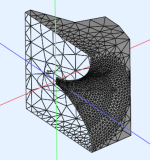
0, 10, 20, 30 Power+DI (Normalized at 10 degrees)
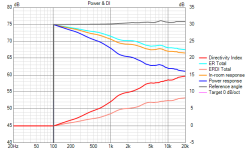
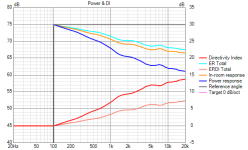
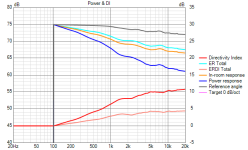
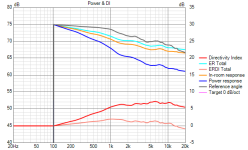
Horizontal / Vertical line charts
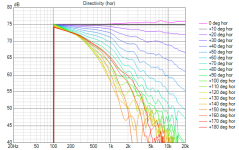
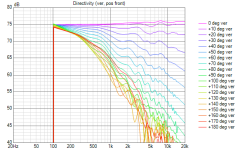
+/-180 polars Horizontal, Vertical
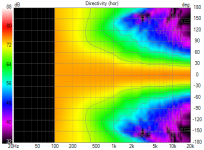
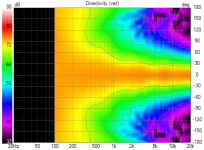
+/-45 polars Horizontal, Vertical
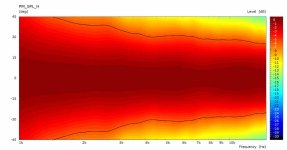
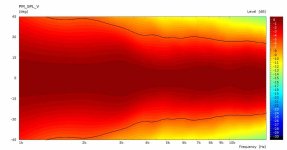
All criticisms welcome because I still don't understand directivity and directivity matching with enclosures: Is this too beamy? Too narrow? Should I flatten DI above 5kHz where MEH ports start harming the polars? Would you even bother building something like this or is it a waste of time?

0, 10, 20, 30 Power+DI (Normalized at 10 degrees)




Horizontal / Vertical line charts


+/-180 polars Horizontal, Vertical


+/-45 polars Horizontal, Vertical


Attachments
Last edited:
Oh btw, that's simulated with FRDs exported after generating in ABEC. Which is why I was thinking FRDs might be more valuable than the configuration file for 3D prints. The effects of the enclosure on the OSSE was a beast to simulate. If you lack computer power (large multi core) the config file won't do what you really want. At least that's my intuition.
I have updated the main body package. At the moment only the main waveguide body and the 36-STD-1 adapter is included. I will update the other adapters soon. So it's now possible to play with the design on your own, if desired.Did you update the products with scripts? I didn't see it in the zip content description on cults....?
Honestly, I don't know a verdict. It kind of narrows but it's still far from a disaster, IMO. It's up to you to try and decide.All criticisms welcome because I still don't understand directivity and directivity matching with enclosures: Is this too beamy? Too narrow? Should I flatten DI above 5kHz where MEH ports start harming the polars? Would you even bother building something like this or is it a waste of time?
The multi-entry setup may bring some advantages that will outweight, I really don't know, but I tend to like it more than dislike 🙂
Last edited:
I don't think there's a right or wrong, just your personal preference. I personally like a narrower dispersion. Smooth handover between drivers is more important to me.
I found Erin at Erin's audio corner on YouTube the most insightful for explaining this as he compares spin data from his Klippel and his listening impressions.
I say build it and see if you like it!
I found Erin at Erin's audio corner on YouTube the most insightful for explaining this as he compares spin data from his Klippel and his listening impressions.
I say build it and see if you like it!
I still don't understand directivity and directivity matching with enclosures: Is this too beamy? Too narrow?
A400G2 waveguided added, size 400mm/15", printer bed 180x180mm required 🙂
The same throat adapters as for the A520G2 are used.


The same throat adapters as for the A520G2 are used.
I've checked desmos and literally every shape is possible. Thank you very much.This is how an extension to a R-OSSE profile can be drawn: https://www.desmos.com/calculator/ph2ckhdurh
These parameters can be directly inserted into Ath and let ABEC to calculate it. I'll describe the procedure in some notes for my models.
It is not completely clear yet (at least for me), how to implement it in Ath script.
Any advise is welcomed.
Everything needed is included in the Gen2 waveguide kits, both A520G2 and A400G2.
(I can always explain the details privately.)
(I can always explain the details privately.)
- Home
- Loudspeakers
- Multi-Way
- Acoustic Horn Design – The Easy Way (Ath4)
